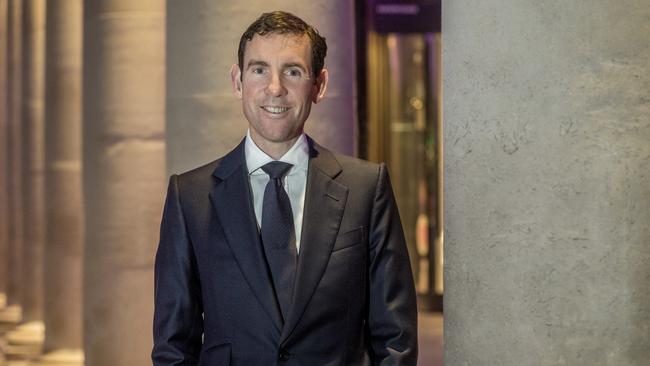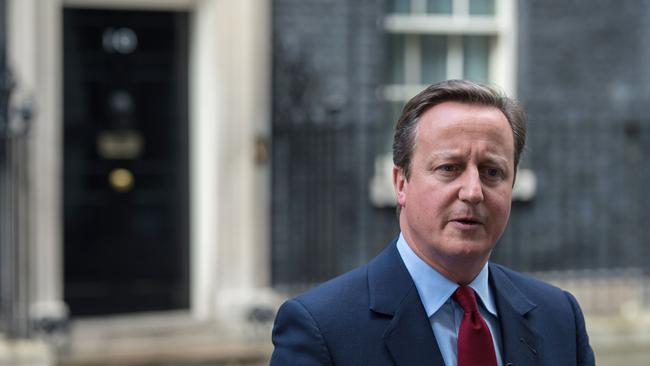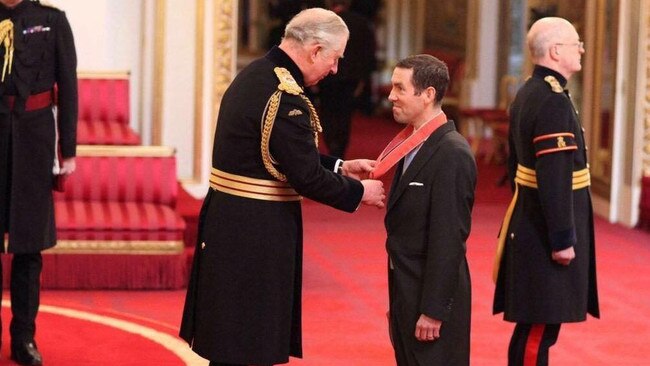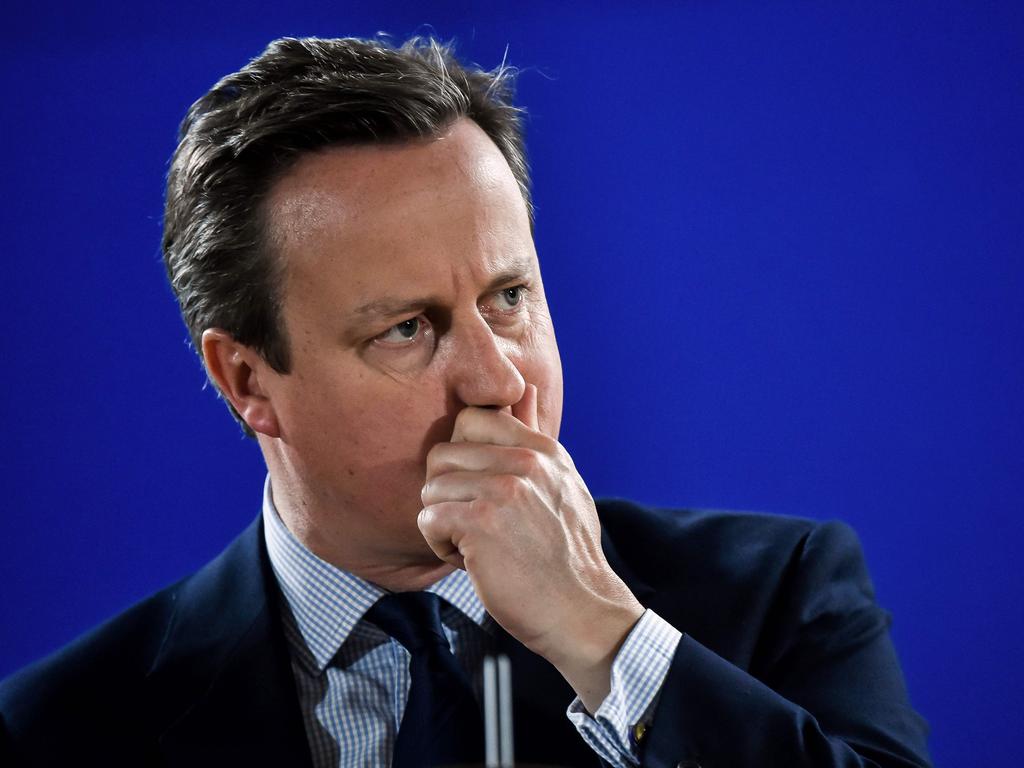How the son of Aussie farmers charmed himself into the heart of the UK government
Lex Greensill was a silver-tongued young banker who seduced David Cameron into backing a huge health deal against civil service advice. Today his empire is in ruins, leaving awkward questions for the former British PM

Lex Greensill was the odd one out. As then British prime minister David Cameron announced a new policy to business leaders gathered in Downing Street on October 23, 2012, he was flanked by three of his closest cabinet colleagues: Oliver Letwin, Michael Fallon and Francis Maude.
Sitting with them at the top table was Greensill, a charming but unknown Australian banker in his thirties. Fresh faced and wearing a jet blue suit, he was neither a minister nor a civil servant.
Still, it was Greensill’s day. That afternoon Cameron was making the Australian’s vision a reality. For almost a year Greensill had enjoyed a security pass to Downing Street, his own team of officials and access to the most powerful civil servant in Britain and the British prime minister himself. Now his plan to get small businesses paid on time was being presented as UK government policy.
Greensill’s final plan captured the zeitgeist of reforming the state and helping small firms at a time of austerity. The government, Cameron told guests, would back an £800m scheme whereby a bank would quickly reimburse pharmacies for the cost of providing prescription drugs instead of making them wait weeks for the UK’s National Health Service to repay them.
What Cameron did not tell those present was who would benefit from the scheme: Greensill’s former bosses at a giant Wall Street bank and, eventually, his own financial services company, Greensill Capital. Instead Cameron praised the “innovative scheme”, declaring: “This government is determined to back all those businesses who aspire to get ahead and take on more people.”

Greensill had far bigger targets in mind. He also wanted to gatecrash the funding of Britain’s Typhoon fighter jets, multibillion-pound contracts to repair its motorways and the overhaul of the railways. Thanks to cabinet secretary Jeremy Heywood he was given access to officials in charge of those projects too.
Today his dreams lie in tatters. The pharmacy scheme has been nationalised and looks set to be wound up; Greensill is silent and his company, which counts Cameron among its advisers, has gone bust, causing a wave of defaults among its clients and putting up to 50,000 jobs at risk. Most at threat is Liberty Steel, the company owned by Sanjeev Gupta, built with Greensill’s financial alchemy and huge injections of taxpayers’ cash.
Cameron, meanwhile, has faced censure for asking Rishi Sunak and Treasury officials to bail out the company using taxpayer-funded loans. He was briefly investigated under lobbying rules he helped create before being cleared on a technicality.
The following account of how Greensill seduced the British establishment is based on extensive leaked minutes and documents from the heart of Whitehall and the testimony of more than a dozen civil servants and bankers with close knowledge of events.
It is a story that shines a light into the least transparent areas of public life: the relationship between ministers and civil servants and the boundary between the state and business. It also poses a grave question: how could a little-known financial whizzkid embed himself into the heart of British government and enrich himself?

The man from Down Under
The ascent of Alexander “Lex” Greensill from the son of Australian sugar cane farmers to celebrated financier began in 2001, when he arrived in Britain aged 24.
Greensill had left school during a harvest that was so bad it dried up his parents’ cash flow. Unable to afford university tuition fees, he studied law by correspondence, receiving cassette tapes in the mail.
Four years after arriving in the UK Greensill joined the American banking giant Morgan Stanley as it was expanding into supply chain finance. This is a decades-old financial tool to help businesses left vulnerable by late payments. Put simply, a bank sandwiches itself between a company and its suppliers and pays bills immediately for a fee.
Greensill knew all about the difference that late payment could make. He chose to specialise in the field.
It was at Morgan Stanley that he also met the man who helped him to make his name: Heywood, who was on a break from Whitehall at the time but would go on to be regarded as the greatest civil servant of his generation. He died of cancer aged 56 in 2018.
At the time Heywood was an investment banker and trying to earn serious money in London. According to former colleagues, his attraction to swashbuckling businesspeople and their whizzy ideas was a key trait.
Heywood’s confidants included Jim Ratcliffe, the Monaco-based billionaire industrialist and financier, and Sir Simon Robey, a banker who spent 25 years at Morgan Stanley before founding his own firm, which today employs the former British chancellor George Osborne.
Charming and articulate, Greensill was a seductive salesman. “He could sell snow to an Eskimo,” one senior businessman said.
Despite sharing no hinterland, he and Heywood got on. Heywood’s stint at Morgan Stanley lasted three years until he returned to advise Gordon Brown in 2008 on the eve of the financial crisis. But his relationship with the young buck endured.
Greensill, meanwhile, kept on climbing. He moved to Citigroup, taking a senior role in its supply chain finance business, and after a couple of years left to set Greensill Capital in 2011.

Greensill gets a foot in the whitehall door
By then, Britain was a different country from the one Greensill had arrived in. Cameron was prime minister and his Conservative-Lib Dem coalition was held together by a single objective: to save the economy. After rescuing Britain’s banks, the frayed public finances gave rise to a new spirit in Whitehall: the civil service would shrink the state, make it more efficient and create a greater role for the private sector, while preserving frontline services such as the NHS.
The young and politically inexperienced Cameron looked to Heywood to give effect to his mission. The civil servant was given a new role: Downing Street permanent secretary, which, allies and critics agreed, endowed him with unparalleled power in government.
A minister recalled: “He had more access to the PM than anyone. You simply couldn’t get to David without going through Jeremy.” An article in the Spectator at the time declared: “Sir Jeremy Heywood is the man who really runs the country.”
It was in this context that Heywood, then 49, used his power to bring Greensill, then 34, into the heart of government.
Towards the end of 2011 he engineered a Whitehall role for Greensill: the banker would spend six months exploring whether supply chain financing could help the state to pay suppliers more quickly. He was given a security pass and four civil servants who were told to explore his ideas, write a report and submit it to ministers. In due course he even got a desk in the economic and domestic affairs secretariat of the Cabinet Office.
With businesses struggling for cash after the credit crunch, who could argue with a scheme that helped small business — at no apparent cost to the taxpayer? Or, as Greensill told it, he could “democratise finance” — helping the little man get access to cash faster.
But from the beginning, Greensill’s presence raised eyebrows. His role was never announced publicly or internally.
For years politicians had made a habit of parachuting businesspeople into Whitehall, so much so that under Brown they had even acquired an acronym: Goats (“government of all the talents”). Cameron had also brought in Philip Green, the owner of high street retailer Topshop, as his “efficiency tsar”.
But Greensill’s ascent rested on a civil servant, not a politician. Maude, the minister responsible for the Cabinet Office, is said to have played no part in his arrival.
A civil servant recalled meeting Greensill for the first time in the Treasury: “Jeremy said, ‘You must meet this incredibly clever person who I met when I was outside government, Lex Greensill, he knows everything about supply chain finance and he’ll be brilliant.’ ”
“I remember thinking at the time: why is Jeremy so up on this guy? It doesn’t make any sense.”
Officials could also see a fundamental flaw in Greensilll’s proposals. Why did the state, with all its resources, need a bank to pay its bills promptly? Why not simply pay them on time itself? As prime minister Brown had introduced a policy which required the government to pay suppliers in five days. “All the government needed to do was enforce it,” an ex-minister said. The officials suspected that Greensill was trying to insert himself into the relationship between the government and its suppliers and take a slice of the huge flows of cash between them.
One official was so concerned about the lack of clarity over Greensill’s position that they repeatedly made a note to speak to Sue Gray, head of the Cabinet Office propriety and ethics team.
Yet questions remained unanswered, in part, officials say, because it was clear that Greensill and his ideas had support from Heywood. On November 20, 2011, Greensill is quoted in notes of one meeting telling another official: “Jeremy is pushing this energetically.”
About this time Heywood summoned Sir Ivan Rogers, a leading civil servant who was about to become Cameron’s adviser on European and global affairs, into his office for a chat. The unexpected subject matter: supply chain finance.
Rogers, 60, who had just had a stint at Citigroup himself, recalled: “Jeremy asked me for any views on quite a long slide deck, which was specifically on what later became the pharmacies supply chain finance proposal.”
He added: “The obvious big issue for anyone looking at this proposal inside government is: if the problem you are aiming to address was caused by systematic late payment within the NHS, why not deal with that problem at source?”
Over the months that followed, Greensill went on a whistlestop tour of Whitehall that brought him into contact with some of the most powerful officials in the country.
Access all areas
On January 24, 2012, Greensill arrived at the Ministry of Defence to make his pitch to officials in charge of buying Britain’s military hardware.
Accompanied by his Cabinet Office team, the Australian requested a rundown of the “toys” the MoD bought. He could see rich pickings: Defence, Equipment & Support, the government’s military procurement division, was responsible for almost £9bn a year of spending on everything from nuclear submarines to aircraft carriers.
The officials, Nick Payne, head of commercial scrutiny and due diligence, and Susanna Mason, DE&S director-general, could not understand why they were being asked to meet an unknown banker. Sir Bernard Gray, the chief of defence materiel, who was later asked to meet Greensill, is understood to have taken a similarly dim view.
Nonetheless, Heywood insisted that the conversation with the MoD should continue, telling a colleague: “Let’s leave no stone unturned about the areas we might look at.”
Defence officials had several more meetings with Greensill in the following months. According to sources, Greensill had two specific proposals: using supply chain finance to pay for the maintenance of the Royal Air Force’s fleet of 14 Voyager air-to-air refuelling planes, and construction of Eurofighter Typhoons. Greensill wanted to insert his company between the defence giant BAE Systems, which builds the fighter jets, and its suppliers.
The meetings, which were ultimately unsuccessful, followed a similar pattern: officials were “palpably confused” as to why they were meeting and who would benefit from the proposals other than the bank which made the upfront payment.
On January 19, 2012, Greensill met Richard Douglas, a director-general at the Department of Health. At the time, the NHS spent at least £10bn a year on private contractors.
Greensill brought up his plan to finance independent pharmacies, which, he assured those present, would not “cost the department anything”. Douglas responded that “to make this work” he would need to show that pharmacies were suffering from late payment issues that merited private finance.

Greensill did not have the evidence. Instead he repeated his mission statement: this was about “democratising” credit. Details could come later.
Even Brendan Peilow, director of the Government Banking Service, who had been assigned to help Greensill, interjected at that point, warning that the plan could pile “risks” and “administrative costs” on the taxpayer. The guests agreed to revisit the idea in due course. The same day, Greensill went to the Highways Agency, another quango, to pitch using supply chain finance in the maintenance and upgrade of the M62, M4 and M5 motorways. Again, he wanted to insert a bank between Balfour Beatty, the construction company running the projects, and its suppliers.
On February 26, Greensill went to see Dave Thomas, the commercial director of Her Majesty’s Revenue and Customs, to make a similar argument.
According to a leaked documents, he visited at least 11 departments or agencies: the Cabinet Office, the Treasury, the MoD, the Department of Business and Instrial Strategy, HMRC, the Department for Transport, the Department of Work and Pensions, the Department for Environment, Food and Rural Affairs (Defra), the Department of Health, Highways England and Network Rail.
Heywood was integral. He had just been promoted to cabinet secretary: the most senior civil servant in the land. But he remained involved with Greensill’s plan, lobbying officials and companies.
On April 19, Heywood met civil servants to firm up support for the “broad policy” and clarify the importance of “department-specific initiatives”. On May 2, he is said to have chaired a meeting with banks who might have backed future schemes, including Barclays, HBSC, Lloyds and, Greensill’s former employer, Citibank.
Individuals who had a financial interest in the proposals, or went on to work with Greensill, also played their part.
One was Maurice Thompson, then the UK chief executive of Citigroup, who later became chairman of Greensill Capital. In 2012 he even invited an official working on the project for lunch at the bank’s headquarters, where he told them how “wonderful Lex is”. Thompson did not respond to requests for comment.
Then there was Bill Crothers, head of the Crown Commercial Service, the government’s procurement arm, with responsibility for spending of £60bn a year. Crothers allegedly helped open doors for Greensill across government, including meeting departmental commercial directors. He later became a director of Greensill’s company.
Civil service revolt
By the middle of 2012, Greensill had made progress with one idea: pharmacies. Part of it was luck. Andrew Lansley, then the health secretary, had pushed through his own controversial reforms to the NHS the previous spring. The health department was under pressure to show that it too cared about efficiency.
Pharmacies were a perfect test case: Greensill could argue the government was helping thousands of often family-owned small businesses which supply prescription drugs to the elderly and vulnerable but then had to wait weeks, even months, for reimbursement by the NHS.
One problem remained: the evidence. Officials figured that even if there was an issue, the government could just improve the NHS Business Authority: a body whose job includes counting prescription invoices and paying pharmacists. There was no need to insert a bank into that process.
One recalls: “I remember Lex arguing, ‘Why don’t you support this.’ I said: ‘I need you to tell me, who’s making money, I need the economics explained’.”
The civil servant added: “If you can’t understand something and it won’t be explained to you, there’s something wrong with it. I certainly didn’t want my minister near it.”
Over the summer, officials wrote and sent a final report on Greensill’s proposals to Maude. Heywood, was “cc’d” in via email as a courtesy. The report is understood to have made clear that supply chain finance was not the most effective way of solving the problem and that there were “better and simpler routes” to pay suppliers, some of which were already in place in Whitehall.

It amounted to a polite “no”. However, shortly after it was submitted, Maude called the report’s main author with unexpected news. He is said to have asked: “Why is there a note (the report) recommending supply chain finance in front of the prime minister? It looks like your work and it’s in front of the PM.”
The official responded: “I have no idea what you are talking about.”
The pair then had a back-and-forth in which another piece of information emerged: the official’s name had been removed from the report and replaced with Greensill’s.
The evidence suggested that somebody had taken the report and edited it to present it as Greensill’s work. Then it had made its way over Maude’s head to be put into Cameron’s red box — his briefcase containing documents to sign off on a given day, which Heywood helped to manage. Greensill is understood to deny any involvement in changing the report.
Cameron, who, one former MP recalls was a “sucker” for an eye-catching scheme, gave the proposal his blessing.
On October 23, the prime minister sat two seats away from Greensill as he announced the government’s groundbreaking commitment to supply chain finance. There was no mention of which bank would be funding the scheme and charging pharmacies.
Only later did the beneficiaries become clear: for the first six years, the scheme was run by Citibank, Greensill’s former employer, which he had left weeks before entering Whitehall. Then, in 2018, Greensill Capital won the contract itself. From July 2018 until last month, Greensill provided £1.2bn ($2.1bn) in loans to pharmacies, taking a fee for every loan.
Ash Soni, the former president of the Royal Pharmaceutical Society, said over the weekend that he resisted a “really big push” from government to get chemists to sign up. He said many chemists became suspicious and refused to take part because it would lead to them losing out financially. The cost of the 1 per cent interest rate being charged by the loan scheme was greater than the cost of any cashflow problems chemists had, he explained. “When you actually did the calculation properly, I don’t think it worked.”
CBE, a job for Cameron then a dramatic fall
Over the past decade Greensill became a celebrated face of finance. His ascent went hand in hand with Gupta, whose acquisition spree he funded.
In 2014 the Australian was made a crown representative — one of a carefully selected cadre of businesspeople advising the government. With the endorsement of politicians — he claimed to advise Barack Obama’s White House — his business grew. He was made a Commander of the British Empire in the Queen’s Birthday Honours List, receiving his award from Prince Charles in 2017.

It is unclear who nominated Greensill for either post: many believe Crothers, then head of government procurement, helped make him crown representative and Heywood secured him the CBE.
He then raided politics and finance for people who could gold-plate his reputation. First he hired Citibank’s Thompson as chairman. Then he poached Crothers as a director. Finally, in 2018, he hired Cameron as an adviser, giving him share options which could be worth tens of millions of pounds.
Greensill seemed invincible: by 2019, when the Japanese investment giant Softbank ploughed in cash, it had offices around the world. By 2020 it was targeting a $US7bn ($9.1bn) valuation.
However, his empire was built on risk. In funding Gupta’s growth, Greensill expanded into ever more exotic forms of supply chain finance, even lending the steel tycoon cash based on sales more than three years in the future.
Greensill financed a string of deals for Gupta, who bought tired steel and aluminium plants from Scotland to Australia aided by generous state support. Those deals were packaged into complex financial instruments, sold to investors including Swiss firms GAM and Credit Suisse.
By the time of its implosion Greensill had an estimated $US5bn of exposure to the steel baron. Its collapse was triggered by a Japanese insurer pulling the plug on Credit Suisse’s vast exposure to Gupta. About 5000 British jobs at Gupta’s steel mills hang in the balance.
Cameron has remained silent. Heywood’s widow, Suzanne, said her husband “was not personally involved in and took no personal benefit of any sort from Lex’s company”.
The Sunday Times







To join the conversation, please log in. Don't have an account? Register
Join the conversation, you are commenting as Logout